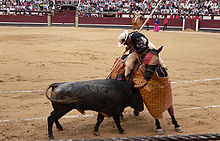Caparison
This articleneeds additional citations forverification.(June 2020) |

Acaparisonis a cloth covering laid over ahorseor other animal for protection and decoration. In modern times, they are used mainly inparadesand forhistorical reenactments.A similar term ishorse-trapper.[1]The word is derived from the Latincaparo,meaning a cape.[2]
Horses
[edit]
In antiquity, a "magnificently caparisoned horse" takes a central place in avisionreported in thedeutero-canonicaltext,2 Maccabees 3:25,which prevents theSeleucidemissaryHeliodorusfrom a planned assault on the Jewishtemple treasuryinJerusalem.[3]
In theMiddle Ages,caparisons were part of the horse armour known asbarding,which was worn duringbattleandtournaments.They were adopted in the twelfth century in response to conditions of campaigning in theCrusades,where local armies employed archers, both on foot and horse, in large quantities. The covering might not completely protect the horse against the arrows but it could deflect and lessen their damage.
An early depiction of a knight's horse wearing a caparison may be seen on the smallCarlton-in-Lindrick knightfigurine from the late 12th century. Modern re-enactment tests have shown that a loose caparison protects the horse reasonably well against arrows, especially if combined with agambeson-like undercloth underneath. Medieval caparisons were frequently embroidered with thecoat of armsof the horse's rider.
In 1507, a horse disguised as aunicornat the tournament of theWild Knight and the Black Ladyin Edinburgh had a caparison of black and white damask lined with canvas.[4]A caparison made of red taffeta for the horseJames VI of Scotlandin June 1591 may have been intended for a masque performed atTullibardine Castle.[5]Velvet caparisons lined with buckram were made forHenrietta Mariaand her gentlewomen in 1630s.[6]
Domesticated and temple elephants of India
[edit]

In the Indian state ofKerala,elephants are decorated during temple festivals. They wear a distinctive golden head covering called anettipattam,which is often translated into English as an elephant caparison. However, it covers only the head, not the body, as in a horse caparison.
See also
[edit]References
[edit]- ^Trapper sold at Christie's
- ^"caparison (n.)".Online Etymology Dictionary. Archived fromthe originalon 2015-03-24.Retrieved20 April2015.
- ^Cline, Eric H. (10 March 2010).Jerusalem Besieged: From Ancient Canaan to Modern Israel.76: University of Michigan Press.ISBN978-0-472-02537-4.
{{cite book}}:CS1 maint: location (link) - ^James Balfour Paul,Accounts of the Treasurer,vol. 3 (Edinburgh, 1901), p. 257.
- ^Michael Pearce, 'Maskerye Claythis for James VI and Anna of Denmark',Medieval English Theatre 43(Cambridge: D. S. Brewer, 2022), p. 118.
- ^Arthur MacGregor, 'Horsegear, Vehicles and Stable Equipment',Archaeological Journal 153(1997), pp. 176, 195.
External links
[edit]- Caparisons in 13th–17th century illustrations and artwork
- A caparison made for the wedding-celebration of Gustaf II Adolf of Sweden and Maria Eleonora of Brandenburg, 1621
- Caparisons in the 14th-century German–Codex Manesse
![]() This article incorporates text from a publication now in thepublic domain:Chambers, Ephraim,ed. (1728). "Caparison".Cyclopædia, or an Universal Dictionary of Arts and Sciences(1st ed.). James and John Knapton, et al.
This article incorporates text from a publication now in thepublic domain:Chambers, Ephraim,ed. (1728). "Caparison".Cyclopædia, or an Universal Dictionary of Arts and Sciences(1st ed.). James and John Knapton, et al.
